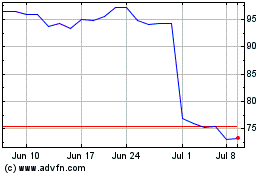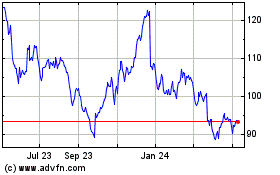By Sara Germano
Nike Inc.'s business is booming but mom-and-pop sneaker shops
find little reason to cheer.
The world's largest maker of sportswear and sneakers is making a
renewed push to boost its direct-to-consumer sales that has smaller
athletic retailers feeling squeezed. Independent sportswear
companies, already struggling with the expansion of online sales
and industry consolidation, now worry that they may not be able to
compete toe-to-toe with vendors like Nike.
Results from Nike's most recent quarter underscore the effort:
business on Nike.com rose 50% for the period ended Nov. 30, while
all direct sales jumped 26%. It is part of a larger endeavor by the
company for direct sales to grow faster than wholesale. By 2020,
Nike projects the segment will more than double to $16 billion and
account for a third of revenue, up from roughly a fifth today.
"In this day and age, with all the athletic brands doing direct
to consumer on their own websites, if customers ever start to view
your store as just a place where they go and pick up an item, like
they go to the grocery store to pick up a loaf of bread, your value
in the equation is diminished," said Brian Shelton, the founder and
owner of Foothills Running Co., a specialty store in Cookeville,
Tenn
.
It doesn't help these specialty retailers that athletic gear is
now everywhere. The so-called athleisure movement of wearing sporty
clothes for non-sport activities means sportswear has moved beyond
athletic retail to fashion boutiques and department stores.
Traditional sellers of sports gear have to work harder to hold on
to their customer base.
Mr. Shelton sees the competition creeping up around him, so he
has cut back on ordering athletic apparel after visits to the local
TJ Maxx showed the store "packed to the gills" with $30 running
shirts. Sometimes, he said, he'll spot his regular customers,
wearing models of running shoes in colors he knows his store never
stocked.
Ray Pugsley, co-owner of the Potomac River Running chain in the
Washington, D.C., area, said as Nike ramps up its direct-sales
business, he is seeing other brands in the sportswear industry,
like Brooks and Saucony, attempt to follow suit.
"They'll tell us with a straight face that online sales really
doesn't do that much volume and it is to increase awareness of the
brand, that we shouldn't be afraid," Mr. Pugsley said. "Time will
tell whether that is a good story to put us at ease, or whether it
could be the truth."
The wholesale ordering process puts small businesses at a
distinct disadvantage. Most of athletic retail operates on a
future-ordering system, whereby retailers place bulk orders for
products from manufacturers like Nike upward of six months ahead of
delivery. But fashion tastes change quickly, and it is tougher for
smaller stores to keep up, since changing orders is costly and
larger chains like Foot Locker Inc. can afford to ship products
directly from Nike or vendor's factories to their own
facilities.
"We have [set] our buying pattern by [the] year, and now they
have color changes every three months," Mr. Pugsley said. "That
causes heartburn for us because people don't realize how the
product cycles work, and people say, 'if they can get it, why can't
you get it?'"
Nike too has more work to do on the logistics front. Inventories
for the most recent quarter rose 11%, largely driven by an 8% rise
in wholesale products. On an earnings call with analysts last week,
executives said Nike's new North American distribution center,
opened in Memphis in June, isn't fully online yet. As Nike
continues to expand its direct sales and clear excess inventory,
Chief Financial Officer Andrew Campion cautioned that margins may
suffer in the short term.
Some smaller retailers have been hit hard by Nike's logistics
issues, saying that in recent months they have faced
product-shipment delays. At least two retailers, who spoke on the
condition of anonymity, said they have seen their orders delayed
for as many as a few weeks to up to three months, in some cases
with products never being delivered.
While such issues appear to be limited in nature, they
underscore Nike's immense presence in the athletic retail world.
The company already controls roughly 60% of the U.S. market for all
athletic footwear, according to industry tracker
SportsOneSource.
Some analysts are questioning whether Nike's growth will come at
the expense of other retailers. Asked about the impact of Nike's
strategy on Dick's Sporting Goods Inc., Chief Executive Ed Stack
said, in a conference call last month, the concern is "overblown"
and that retailers like Dick's have an advantage in offering
consumers a place to shop where they can view products from Nike
alongside competing brands.
City Sports Inc., the Boston-based sportswear chain targeted at
urban professionals, failed to find a buyer in its chapter 11
bankruptcy proceedings. The chain cited increased competition in
the athletic retail market as among the factors that led to its
demise.
The closing of City Sports "was a wake up call," said Mr.
Shelton of Foothills Running. To differentiate himself from the
bigger chains and online retailers, he is now working on rolling
out a free next-day delivery service for loyal customers. At most
other sites, he said, "they get free shipping, but it ain't going
to get here the next day."
Write to Sara Germano at sara.germano@wsj.com
(END) Dow Jones Newswires
December 27, 2015 18:37 ET (23:37 GMT)
Copyright (c) 2015 Dow Jones & Company, Inc.
Nike (NYSE:NKE)
Historical Stock Chart
From Mar 2024 to Apr 2024

Nike (NYSE:NKE)
Historical Stock Chart
From Apr 2023 to Apr 2024
